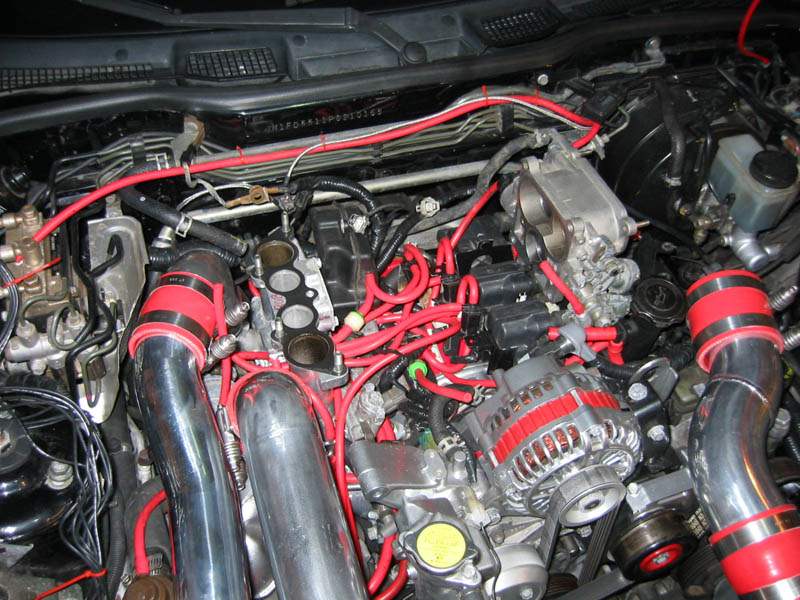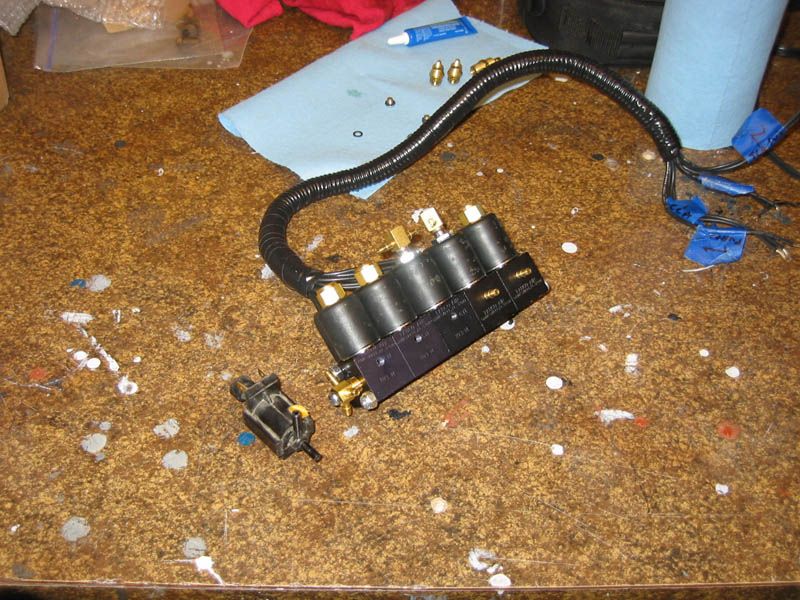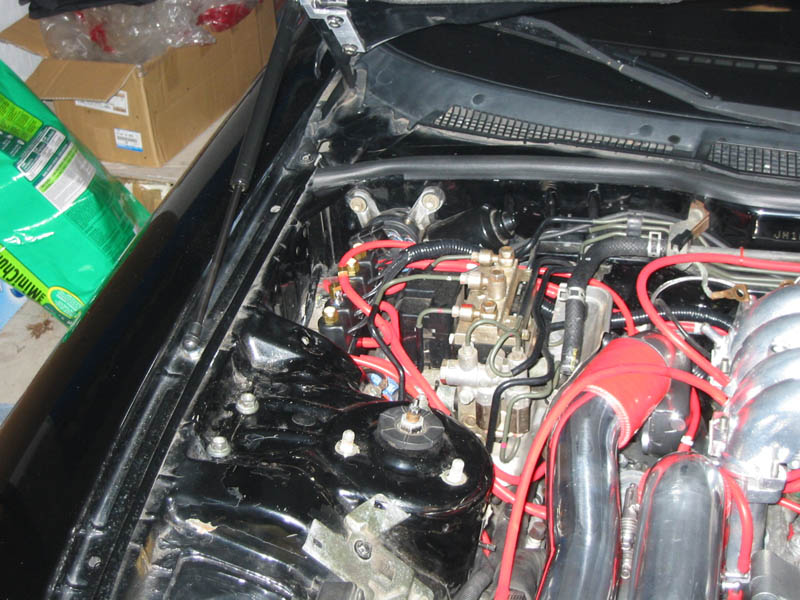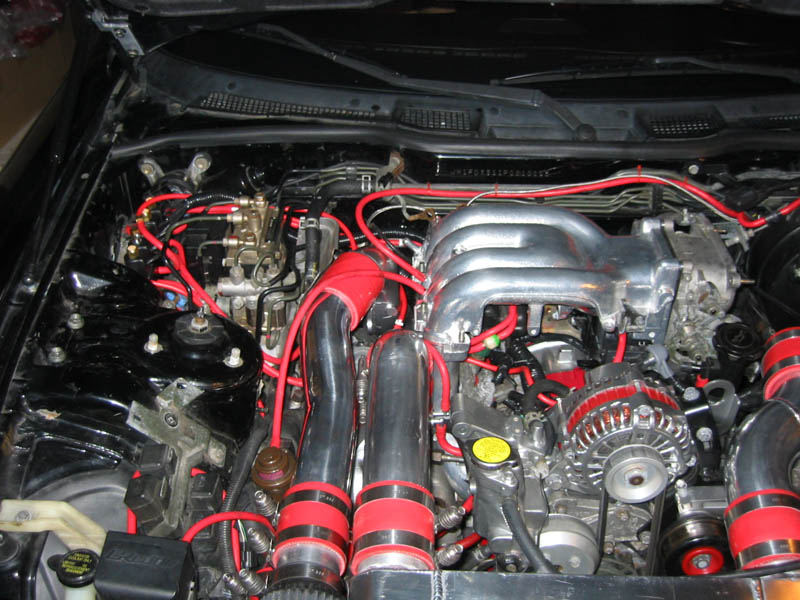Custom replacement solenoid system
#1
First, some background info: As many of you know, I recently completed my rebuild/upgrade (see: This Thread ). The primary function of the car is street/autocross use (with the occasional HPDE). As such, I switched to a simplified sequential 99spec setup (I've driven a few cars with a properly set up non-seq system, and I absolutely hated it. Also had no interest in single turbo). The simp-seq is nice, but still has a few annoyances. First, it still uses the stock solenoids (I had 2 fail since I finished the rebuild, and plenty before that). Second, since I removed the rack for the solenoids to attach to, the leftover hoses and valves created a complete mess under the UIM:

So I set out to learn more about solenoids and vacuum control systems so I could build an aftermarket system. Some may argue that there really is no advantage to this, but I figured that I might as well try it out and see what happens.
Basically, what I ended up building is a completely custom 5-solenoid setup (I'm running simplified sequential, so I only have the following solenoids: Purge Control, CCA, CRV, TCA (pressure), TCA (vacuum). These solenoids can be bolted together in almost any combination imaginable.
Solenoid specs:
Viton seals
Stainless steel internals
Molded coil (resistant to water, and high temperatures)
Custom aluminum manifolds
100psi rating
Use custom #10-32 brass nipples
Better flow and reaction time than stockers
Rebuildable
Cheaper than stockers (approximately $40ea)
Here are a few pics of the setup (note the stock solenoid in the picture for size reference).


So I set out to learn more about solenoids and vacuum control systems so I could build an aftermarket system. Some may argue that there really is no advantage to this, but I figured that I might as well try it out and see what happens.
Basically, what I ended up building is a completely custom 5-solenoid setup (I'm running simplified sequential, so I only have the following solenoids: Purge Control, CCA, CRV, TCA (pressure), TCA (vacuum). These solenoids can be bolted together in almost any combination imaginable.
Solenoid specs:
Viton seals
Stainless steel internals
Molded coil (resistant to water, and high temperatures)
Custom aluminum manifolds
100psi rating
Use custom #10-32 brass nipples
Better flow and reaction time than stockers
Rebuildable
Cheaper than stockers (approximately $40ea)
Here are a few pics of the setup (note the stock solenoid in the picture for size reference).
#2
Even though these solenoids can take the heat of the engine bay, I decided that I was going to move them out from underneath the UIM. Couple of reasons for that: It will help move some heat-storing mass away from that area (hopefully helping out the coils, fuel system, and intake manifold). It's a little easier to get to the vacuum lines/solenoids for diagnosis. And lastly, I think it gives it a slightly cleaner look.
I decided to place the solenoids next to the passenger fender, right behind the ABS system. There is just enough room for the solenoids in this location, and the lines aren't any longer than they were when the solenoids were under the UIM. The only modification needed, was that the wires for the airbag had to be unbolted from their bracket and lowered slightly. After that, the solenoid rack dropped right in.
Here are a few preliminary mock-ups of what it'll look like when I'm completely finished:


Testing of this system will begine shortly (later this week, after the snow has melted). I'll post any and all results.
-Rob
I decided to place the solenoids next to the passenger fender, right behind the ABS system. There is just enough room for the solenoids in this location, and the lines aren't any longer than they were when the solenoids were under the UIM. The only modification needed, was that the wires for the airbag had to be unbolted from their bracket and lowered slightly. After that, the solenoid rack dropped right in.
Here are a few preliminary mock-ups of what it'll look like when I'm completely finished:
Testing of this system will begine shortly (later this week, after the snow has melted). I'll post any and all results.
-Rob
#7
That is simply BAD ***. VERY good work!
I've considered doing something similiar, but I was stymied trying to find a suitable replacement solenoid - looks like you found a winner!
You could almost do something approaching the '96+ solenoid "black box" that Mazda went to. It has less inputs and internally split the signals in molded plastic pathways, bigtime simplifying things. If you think about it, there's only a few inputs, but the inputs get split to different solenoids, etc.
Something like this could also be possible with the stock solenoids - moving them to that location would remove them from their heat source, and in a way moves them closer to what they're supposed to be controlling - the turbos themselves.
Keep us posted on your progress! I'm eatin' this up!
Dale
I've considered doing something similiar, but I was stymied trying to find a suitable replacement solenoid - looks like you found a winner!
You could almost do something approaching the '96+ solenoid "black box" that Mazda went to. It has less inputs and internally split the signals in molded plastic pathways, bigtime simplifying things. If you think about it, there's only a few inputs, but the inputs get split to different solenoids, etc.
Something like this could also be possible with the stock solenoids - moving them to that location would remove them from their heat source, and in a way moves them closer to what they're supposed to be controlling - the turbos themselves.
Keep us posted on your progress! I'm eatin' this up!

Dale
Trending Topics
#12
Coming from a 3 month journey on fixing my sequential system, I know how difficult the turbo system is to work on. I am very impressed by the progress you have made on your project -- I hope the solenoid rack works.

#13
J.S.J did something similar to his car a few months back. However, he created a boost problem in doing so and I never read that he fixed the problem (and I believe he recently sold his car).
Looking forward to hearing your results. Hopefully you'll have some better luck than J.S.J did with his project.
Looking forward to hearing your results. Hopefully you'll have some better luck than J.S.J did with his project.
#14
WOW! Looks great. You make me wish I had not done a new hose job last spring. Still, this should make things way easier to diagnose. Keep us up to date when you road test. Then a writeup on the solenoids would be great.
#15
Originally Posted by Mahjik
J.S.J did something similar to his car a few months back. However, he created a boost problem in doing so and I never read that he fixed the problem (and I believe he recently sold his car).
Looking forward to hearing your results. Hopefully you'll have some better luck than J.S.J did with his project.
Looking forward to hearing your results. Hopefully you'll have some better luck than J.S.J did with his project.
I'm still keeping my fingers crossed with my project. We'll find out what happens soon enough. I'll post my results (good or bad).
-Rob
#16
Originally Posted by DaleClark
That is simply BAD ***. VERY good work!
I've considered doing something similiar, but I was stymied trying to find a suitable replacement solenoid - looks like you found a winner!
You could almost do something approaching the '96+ solenoid "black box" that Mazda went to. It has less inputs and internally split the signals in molded plastic pathways, bigtime simplifying things. If you think about it, there's only a few inputs, but the inputs get split to different solenoids, etc.
Something like this could also be possible with the stock solenoids - moving them to that location would remove them from their heat source, and in a way moves them closer to what they're supposed to be controlling - the turbos themselves.
Keep us posted on your progress! I'm eatin' this up!
Dale
I've considered doing something similiar, but I was stymied trying to find a suitable replacement solenoid - looks like you found a winner!
You could almost do something approaching the '96+ solenoid "black box" that Mazda went to. It has less inputs and internally split the signals in molded plastic pathways, bigtime simplifying things. If you think about it, there's only a few inputs, but the inputs get split to different solenoids, etc.
Something like this could also be possible with the stock solenoids - moving them to that location would remove them from their heat source, and in a way moves them closer to what they're supposed to be controlling - the turbos themselves.
Keep us posted on your progress! I'm eatin' this up!

Dale
I actually considered trying to get my hands on a 96+JDM solenoid unit to test. There were a couple of things preventing me from doing this though. 1) the unit is one gigatic box. Wiring it would be a pain, as would diagnosing any problems. 2) Any small failure of an internal portion would require replacement of the entire system. 3) I'm not positive of the make-up of the internals. If I am going through the trouble to do this, I wanted to be sure than the equipment is better than stock. 4) Not easy to get my hands on one, and it would probably be $$$ if I could.
I also contemplated using the stock solenoids as you mentioned (similar to what J.S.J did). But again, if at all possible, I wanted the equipment to be of better quality than the stockers. I was also looking for something a little cheaper, as buying brand new solenoids from the dealer is fairly expensive.
-Rob
#17
Originally Posted by eyecandy
That looks awesome!!! By any chance do you have a write up on how do make the seloniods? I would be interested. And roughly what it cost you to make the whole kit.
This particular prototype probably cost about $275 to build (maybe a little more). For the final versions, you can estimate about $45-50 per solenoid.
-Rob
#19
Originally Posted by saxyman990
Thanks Dale!
I actually considered trying to get my hands on a 96+JDM solenoid unit to test. There were a couple of things preventing me from doing this though. 1) the unit is one gigatic box. Wiring it would be a pain, as would diagnosing any problems. 2) Any small failure of an internal portion would require replacement of the entire system. 3) I'm not positive of the make-up of the internals. If I am going through the trouble to do this, I wanted to be sure than the equipment is better than stock. 4) Not easy to get my hands on one, and it would probably be $$$ if I could.
I also contemplated using the stock solenoids as you mentioned (similar to what J.S.J did). But again, if at all possible, I wanted the equipment to be of better quality than the stockers. I was also looking for something a little cheaper, as buying brand new solenoids from the dealer is fairly expensive.
-Rob
I actually considered trying to get my hands on a 96+JDM solenoid unit to test. There were a couple of things preventing me from doing this though. 1) the unit is one gigatic box. Wiring it would be a pain, as would diagnosing any problems. 2) Any small failure of an internal portion would require replacement of the entire system. 3) I'm not positive of the make-up of the internals. If I am going through the trouble to do this, I wanted to be sure than the equipment is better than stock. 4) Not easy to get my hands on one, and it would probably be $$$ if I could.
I also contemplated using the stock solenoids as you mentioned (similar to what J.S.J did). But again, if at all possible, I wanted the equipment to be of better quality than the stockers. I was also looking for something a little cheaper, as buying brand new solenoids from the dealer is fairly expensive.
-Rob
I attached 2 pics - one of which you can clearly see a stock check valve. I do like how it has common "manifolds" feeding the solenoids - pretty slick.
Dale
#20
Dale, another concern I would have is whether or not the 16bit ecu has any control over the box (I'm pretty sure it does). With that, I would really question whether or not it would even work with our ecu.
#21
Very cool.
To ensure you don't have any funny boost results, I suggest comparing the new length of vacuum line to the stock lengths. Making the hose lines too long could cause delayed responses of the solenoids and actuators. Substituting portions of hard pipe might work well.
Dave
To ensure you don't have any funny boost results, I suggest comparing the new length of vacuum line to the stock lengths. Making the hose lines too long could cause delayed responses of the solenoids and actuators. Substituting portions of hard pipe might work well.
Dave
#22
Originally Posted by WaLieN
Dale, another concern I would have is whether or not the 16bit ecu has any control over the box (I'm pretty sure it does). With that, I would really question whether or not it would even work with our ecu.
Dale
#23
I looked into this a while back, but couldn't find solenoids rated at a high enough temperature. What temperature are these rated for? I like how you use a common manifold. Very clean.
I even found some solenoids with viton internal seals. Pretty slick.
Moving the rack out from under the UIM should aid in debugging if something does go wrong. Anyone ever measure the temperature under the UIM?
Good job.
I even found some solenoids with viton internal seals. Pretty slick.
Moving the rack out from under the UIM should aid in debugging if something does go wrong. Anyone ever measure the temperature under the UIM?
Good job.
#24
Originally Posted by saxyman990
Actually, most of these components were produced locally and can only be aquired through an authorized distributor. Fortunately, I just happen to be one of those "authorized distributors." Once I get this system up and running, and I complete thorough tests to verify that it'll meet requirements, I will consider building these and distruting them to anyone interested. Keep in mind that I can custom design and produce virtually any system you want. So whether you want an entire rack of 12 solenoids, or only 4, if can easily be done.
This particular prototype probably cost about $275 to build (maybe a little more). For the final versions, you can estimate about $45-50 per solenoid.
-Rob
This particular prototype probably cost about $275 to build (maybe a little more). For the final versions, you can estimate about $45-50 per solenoid.
-Rob
Any idea when you'l have this kit for sale ?
:-) neil





